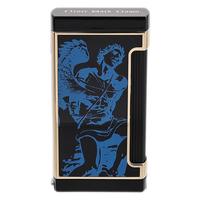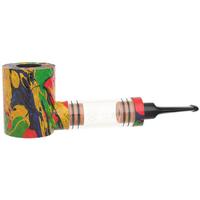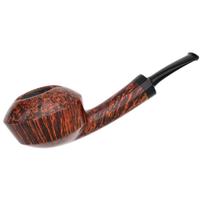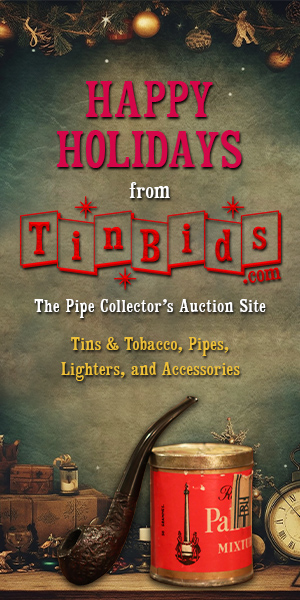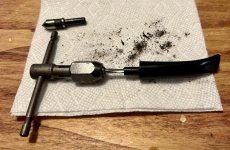That's a discussion that's started many wars on here.Does this mean that all these guys who are hot water flushing their pipes after every smoke are badly oxidizing their vulcanite stems from the inside out?
Fixed bend but now look!
- Thread starter Old_Woodsman
- Start date
You are using an out of date browser. It may not display this or other websites correctly.
You should upgrade or use an alternative browser.
You should upgrade or use an alternative browser.
You may enjoy juma stems. Vulcanite softness without the oxidation.I understand what you're saying about buffing the edges and rounding them. I do this on my pipes and though it may be thought anathema I have even sanded down some of the sharp corners on bits because they were not comfortable in my mouth. If a pipe is not comfortable in my mouth, I won't smoke it. I buy mostly old pipes and bought a new pipes in years. I think the newest pipe I have is a 1990 Comoy Christmas pipe, and it's not broken in yet. I much prefer the older pipes because of the way they smoke, and they seem to have better stems. I only smoke pipes with vulcanite stems because I found lucite stems too hard and they seem to cause condensation in the few I have tried.
I started smoking pipes in the 1970s and it wasn't until the 1980s that I was introduced to estate pipes. There wasn't anyone I knew then who was worried about the edges on a stem. If the lip was large enough that I could hold it in my teeth, that was all that mattered. Most of the better pipes I have had already been buffed many times before I acquired them.
I can see the pipe smoking hobby has definitely changed in the last 30 years! The same can be said for the hobby of collecting old pocket knives. Twenty years ago the standard was buff them until they are shinny. It was not uncommon to see a seller listing a knife as "buffed to mint." Which is nonsensical, but that was what sold at shows. Most of that generation has gone now, the sellers and the repairmen who did their buffing. Today's pocket knife collectors are looking for true mint knives, in the factory box or tube with the original paperwork.
It appears a similar transformation has taken place in the pipe smoking/ collecting hobby in the 20 years that I had stopped smoking.
I learned something new today and for that I thank you. It keeps old age and retirement from getting too boring!
Did you write that? The grammar is woeful. In fact, I am not sure if you're being serious. Or maybe it's one of those American cartoons for children? Either way, bless........
If you prefer finishing the “back to black” by sanding per hand it’s up to you. Sure in some hands a wheel can ruin the lines of a stem in no time.Compound bars are just sandpaper grit in a matrix of waxy stuff.
Meaning you are still sanding. The rubber doesn't care if the grit is on a wheel or attached to a backing sheet.
Doing it by hand offeres MUCH more control. Something that is a Very Big Deal when retaining crisp edges is a Good Thing (which is always), and blurring/rounding edges is a Bad Thing (which also is always.)
All square, diamond, and faceted stems look like shit if their edges have been blurred/rounded. Buttons, too, if the original had edges. Also, the edges of the bite zone on any shape stem.
I've handled many four figure collectables that originally had "edged" stems and had lost their crispness from buffing instead of careful hand sanding. In some cases they couldn't be rescued (too much material gone), and a new stem had to be made.
Though the following stem had to be replaced anyway because of bite damage, a look at the original illustrates exactly what I'm talking about:
Full-panel S. Bang billiard re-stem - pipemakersforum.com
www.pipemakersforum.com
Bottom line: If sanded by hand to a high grit (1500 wet or dry used wet) very little "machine sanding" is required. A quick touch with some Monzerna medium will shine instantly. Another touch with fine will have it gleaming like glass.
Still there is only a little to do afterwards the acetic acid method compared to sanding the whole stuff off the stem with different grids. As Insider to pipe renovation you know how long that takes. And then you didn’t even touch the corroded airway.
But as said before it is not everyone’s cup of tea.
I have not heard of juma, what is it, and where can I have such a stem made. I have a Stanwell Golden King that needs a new stem.You may enjoy juma stems. Vulcanite softness without the oxidation.
Thank you!
A few artisans are using it now. Stem replacement specialists such as Briarville may be using it.I have not heard of juma, what is it, and where can I have such a stem made. I have a Stanwell Golden King that needs a new stem.
Thank you!
Did you write that? The grammar is woeful. In fact, I am not sure if you're being serious. Or maybe it's one of those American cartoons for children? Either way, bless........
Um, no. It's just something from the Interweb.
It's called a "joke".
Prompted by the fact that using hot water is specifically mentioned as a bad idea for heating stems for bending---because it can cause deep oxidation---every time the question gets asked on this forum.
At last count, that was 8,933,655,721 times.
In the last three months.
Still there is only a little to do afterwards the acetic acid method compared to sanding the whole stuff off the stem with different grids. As Insider to pipe renovation you know how long that takes. And then you didn’t even touch the corroded airway.
I guarantee that a stem can be de-greened inside and out using paper and a tapered drill bit in less time than using a chemical soak followed by sanding (which will also leave the airway textured instead of smooth).
Less mess, less fuss, better result = no brainer
Thats what I use...No one talks about Flitz anymore?
I totally believe you and agree... but how would you get into a bent stem like this?I guarantee that a stem can be de-greened inside and out using paper and a tapered drill bit in less time than using a chemical soak followed by sanding (which will also leave the airway textured instead of smooth).
A polishing compound thats safe for plastics & rubbers.What’s Flitz?
So, you just don't get in to the bend to wallow out the draft there? Thanks, I was just curious, and the idea came to me from another thread post also.Like this, then follow with a bristle cleaner covered in polishing compound clamped in a vice.View attachment 197455
No, the water must be hotter than the usual 120-140 degrees that comes from the spigot to raise oxidation, or folks wouldn’t use hot tap water.Does this mean that all these guys who are hot water flushing their pipes after every smoke are badly oxidizing their vulcanite stems from the inside out?
Ebonite bends about 160 degrees.
Water boils at 212 degrees, and somewhere close below is where folks bend stems and the result is instant oxidation.
The ebonite on this early twenties WDC Milano Extra is a century old.
View attachment 197456
There must have been grades of ebonite.
The best pipes used better.
How else could a hundred year old rubber stem still shine as much?
When I rinse my pipes, I don't even wait for the water to heat up. I am following up the rinse with a pipecleaner anyways, so no big deal if I don't scald out all of the gunk in one rinse.No, the water must be hotter than the usual 120-140 degrees that comes from the spigot to raise oxidation, or folks wouldn’t use hot tap water.
Ebonite bends about 160 degrees.
Water boils at 212 degrees, and somewhere close below is where folks bend stems and the result is instant oxidation.
The ebonite on this early twenties WDC Milano Extra is a century old.
View attachment 197456
This 7 point star Lee is 75 plus years old.
View attachment 197457
I removed all the slight oxidation and made the gold stars shine on this 75 something year old $30 Lee in a few minutes using Everclear, grapeseed oil, 4/0 steel wool, paper napkins and elbow grease. When it does dull it won’t take much to make it glow again.
That Lee cost ten dollars when ten dollars would buy seven or ten high quality Yello Bole pipes,,,,twenty years before Brylon and polystyrene stems.
View attachment 197458
Sadly, you got what you paid for, in that old sin cussed world of the late forties.
Three Star grade Lees were worth ten dollars in 1946.
They’d be a $150 pipe today, if they were still made.
I removed all the slight oxidation and made the gold stars shine on this 75 something year old $30 Lee in a few minutes using Everclear, grapeseed oil, 4/0 steel wool, paper napkins and elbow grease. When it does dull it won’t take much to make it glow again.
That Lee cost ten dollars when ten dollars would buy seven or ten high quality Yello Bole pipes,,,,twenty years before Brylon and polystyrene stems.
View attachment 197458
Sadly, you got what you paid for, in that old sin cussed world of the late forties.
Three Star grade Lees were worth ten dollars in 1946.
They’d be a $150 pipe today, if they were still made.
Not a criticism, because you do your pipes to what makes you happy. But, if I may point out for others.... putting oil on a non-polished pipe, does make it look good temporarily. But of you want to slow down oxidation to almost nil, and have a stem that is more aesthetically pleasing to the touch, then a set of cheap micro mesh p[ads will get you all the way down to a high gloss surface. Do not oil between meshes. I take a paper hole punch and put holes in the corner of each mash pad, and then string them onto a beaded chain in order of abrasiveness like this...View attachment 197457
I removed all the slight oxidation and made the gold stars shine on this 75 something year old $30 Lee in a few minutes using Everclear, grapeseed oil, 4/0 steel wool, paper napkins and elbow grease. When it does dull it won’t take much to make it glow again.
That Lee cost ten dollars when ten dollars would buy seven or ten high quality Yello Bole pipes,,,,twenty years before Brylon and polystyrene stems.
View attachment 197458
Sadly, you got what you paid for, in that old sin cussed world of the late forties.
Three Star grade Lees were worth ten dollars in 1946.
They’d be a $150 pipe today, if they were still made.
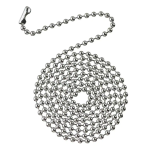
Then starting at the most abrasive, I will work them down under running water, just a few thorough passes per pad, up to the glassy one. Then I buff slightly with a jeweler's cloth, and then use a touch of Renaissance Wax, but if one wanted to use an oil, that would be the time to use it. I have a bench lathe that I could buff to a polish, but even with the experience of a lifelong jeweler, just too much pressure can misshape you stem, or slang the thing. It doesn't take me long to use the pads. And, once you have them polished, it doesn't take much to keep them shiny. I just hit them with a jeweler's cloth before racking them, and occasionally use a touch of the wax mentioned... and it will be years before I have to even consider polishing again... if ever.
I am almost shure that a pro like you can do that in a short time. I can’t.I guarantee that a stem can be de-greened inside and out using paper and a tapered drill bit in less time than using a chemical soak followed by sanding (which will also leave the airway textured instead of smooth).
Less mess, less fuss, better result = no brainer
It would take at least half an hour to remove the green with paper, another quarter to prepare it for the wheel. And maybe I would have removed more material than necessary.
In contrary to a pro like you I am just a humble servant in the holy community of pipe renewal that answered a question how to get rid of the green with an acidic solution in the best sense of the word.
The tapered drill is a good idea.
Go on...That's a discussion that's started many wars on here.



